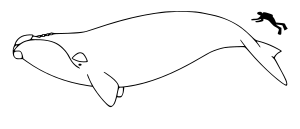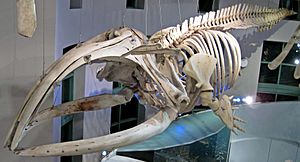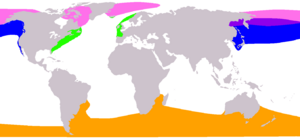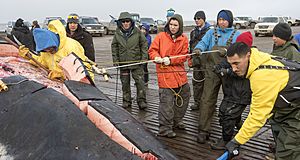Balaenidae facts for kids
Quick facts for kids BalaenidaeTemporal range: Miocene to present
|
|
|---|---|
 |
|
| Montage of two extant balaenids, Balaena mysticetus (right) and Eubalaena australis (left) | |
| Scientific classification |
|
| Kingdom: | Animalia |
| Phylum: | Chordata |
| Class: | Mammalia |
| Order: | Artiodactyla |
| Infraorder: | Cetacea |
| Parvorder: | Mysticeti |
| Family: | Balaenidae Gray, 1821 |
| Type genus | |
| Balaena Linnaeus, 1758
|
|
| Genera | |
|
Balaena |
|
Balaenidae (say: bah-LAY-nih-day) is a family of large whales. These whales are part of a group called Mysticeti, also known as baleen whales. This family includes two types of whales that are still alive today: the right whale (from the genus Eubalaena) and the bowhead whale (from the genus Balaena). Many other whales in this family are only known from fossils.
Contents
What are Balaenidae Whales?
Balaenidae whales are known for their huge size and special way of eating. They are some of the largest animals on Earth. They live in cold and cool waters around the world.
Types of Balaenidae Whales
Scientists group living things into families, genera, and species. Here are the main types of Balaenidae whales:
- Family Balaenidae
- Genus Balaena
- Bowhead whale, Balaena mysticetus
- Genus Eubalaena (Right Whales)
- North Atlantic right whale, Eubalaena glacialis
- North Pacific right whale, Eubalaena japonica
- Southern right whale, Eubalaena australis
- Genus Balaena
For a long time, scientists thought all right whales were just one species. But in 2000, they used DNA studies to look at right whales from different parts of the ocean. They found that the whales in the North Atlantic, North Pacific, and Southern Hemisphere were actually three different species. This idea was supported by more DNA tests in 2005. Now, these three groups are treated as separate species to help protect them better.
How Balaenidae Whales Evolved
Baleen whales are a special group of cetaceans (which include whales, dolphins, and porpoises). They are known for their filter-feeding method. This means they strain their food from the water. Balaenidae whales are one of four main groups of baleen whales. The other groups include pygmy right whales, gray whales, and rorquals (like humpback whales). Scientists are still learning about how all these whale groups are related. But they agree that Balaenidae whales form their own unique group.
What Balaenidae Whales Look Like

Balaenidae whales are very big. Adult whales are usually about 15 to 17 meters (45–50 feet) long. They can weigh between 50 and 80 tons, which is like many school buses!
Their most unique feature is their narrow, arched upper jaw. This shape gives them a deeply curved mouth. This special jaw allows them to have very long baleen plates. Baleen plates are like giant combs in their mouths. They use these plates to eat by "ram feeding." This means they swim with their mouths open near the surface of the water for several minutes. They strain tiny food items from the water, then use their tongues to scrape the food off the baleen plates. Their diet is mostly small crustaceans, like copepods, and sometimes krill.

These whales are also very strong and round compared to other whales. They don't have the grooves on their throats that some other whales do. Their heads are super big, sometimes making up 40% of their total body length, like the bowhead whale. They have short, wide flippers and do not have a dorsal fin (the fin on their back).
All Balaenidae whales travel to different places. They move to warmer waters during the winter. This is when they find mates and give birth. A mother whale is pregnant for about 10 to 11 months. She usually gives birth to one baby every three years.
Where Balaenidae Whales Live
The four living species of Balaenidae whales live in cool and cold waters.
- The North Atlantic right whale (Eubalaena glacialis) lives in the North Atlantic Ocean.
- The North Pacific right whale (Eubalaena japonica) lives in the North Pacific Ocean.
- The Southern right whale (Eubalaena australis) lives in the Southern Hemisphere.
- The bowhead whale (Balaena mysticetus) lives in the Arctic and sub-Arctic waters.
These whales can grow up to 18 meters long and weigh over 100 tons when they are fully grown.
Whaling and Protecting These Whales
Balaenidae whales can live for over 70 years. In the late 1800s, people hunted them a lot for their blubber. Blubber is a thick layer of fat under their skin. About 40% of a right whale's body is blubber. This made them the "right" whale to hunt because they gave a lot of oil. Also, after they were killed, their large blubber deposits made them float. This made it easier for whalers to collect the oil.
Today, many Balaenidae whales are in danger. The North Atlantic right whale is one of the most endangered great whales. There are only about 300-350 of them left. The North Pacific right whale is also endangered, with only about 500 individuals.
However, the Southern right whale and the Bowhead whale populations are doing better. There were about 7,500 Southern right whales in 1997. Bowhead whales have a population of 20,000 to 40,000. This is because whale hunting has been greatly reduced by international agreements. People are working hard to protect these amazing animals.
Images for kids
See also
 In Spanish: Balénidos para niños
In Spanish: Balénidos para niños





